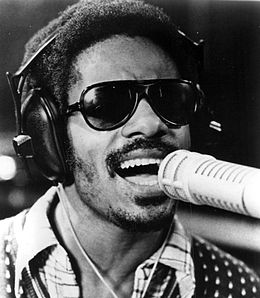
An effects unit or effects pedal is an electronic device that alters the sound of a musical instrument or other audio source through audio signal processing.

A subwoofer is a loudspeaker designed to reproduce low-pitched audio frequencies known as bass and sub-bass, lower in frequency than those which can be (optimally) generated by a woofer. The typical frequency range for a subwoofer is about 20–200 Hz for consumer products, below 100 Hz for professional live sound, and below 80 Hz in THX-certified systems. Thus one or more subwoofers are important for high quality sound reproduction as they are responsible for the lowest two to three octaves of the ten that are audible. This very low-frequency (VLF) range reproduces the natural fundamental tones of the bass drum, electric bass, double bass, grand piano, contrabassoon, tuba, in addition to thunder, gunshots, explosions, etc.

A high-pass filter (HPF) is an electronic filter that passes signals with a frequency higher than a certain cutoff frequency and attenuates signals with frequencies lower than the cutoff frequency. The amount of attenuation for each frequency depends on the filter design. A high-pass filter is usually modeled as a linear time-invariant system. It is sometimes called a low-cut filter or bass-cut filter in the context of audio engineering. High-pass filters have many uses, such as blocking DC from circuitry sensitive to non-zero average voltages or radio frequency devices. They can also be used in conjunction with a low-pass filter to produce a band-pass filter.

A microphone, colloquially called mic, is a transducer that converts sound into an electrical signal. Microphones are used in many applications such as telephones, hearing aids, public address systems for concert halls and public events, motion picture production, live and recorded audio engineering, sound recording, two-way radios, megaphones, and radio and television broadcasting. They are also used in computers for recording voice, speech recognition, VoIP, and for other purposes such as ultrasonic sensors or knock sensors.

Surround sound is a technique for enriching the fidelity and depth of sound reproduction by using multiple audio channels from speakers that surround the listener. Its first application was in movie theaters. Prior to surround sound, theater sound systems commonly had three screen channels of sound that played from three loudspeakers located in front of the audience. Surround sound adds one or more channels from loudspeakers to the side or behind the listener that are able to create the sensation of sound coming from any horizontal direction around the listener.
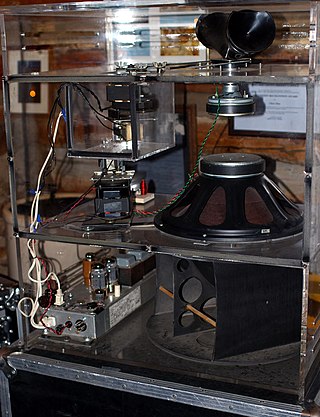
The Leslie speaker is a combined amplifier and loudspeaker that projects the signal from an electric or electronic instrument and modifies the sound by rotating a baffle chamber ("drum") in front of the loudspeakers. A similar effect is provided by a rotating system of horns in front of the treble driver. It is most commonly associated with the Hammond organ, though it was later used for the electric guitar and other instruments. A typical Leslie speaker contains an amplifier, a treble horn and a bass speaker—though specific components depend upon the model. A musician controls the Leslie speaker by either an external switch or pedal that alternates between a slow and fast speed setting, known as "chorale" and "tremolo".

A ribbon microphone, also known as a ribbon velocity microphone, is a type of microphone that uses a thin aluminum, duraluminum or nanofilm of electrically conductive ribbon placed between the poles of a magnet to produce a voltage by electromagnetic induction. Ribbon microphones are typically bidirectional, meaning that they pick up sounds equally well from either side of the microphone.
Electro-Voice (EV) is an American manufacturer of audio equipment, including microphones, amplifiers, and loudspeakers, focused on pro audio applications such as sound reinforcement. As a subdivision of Bosch Communications Systems Inc. since 2006, Electro-Voice markets products for use by consumers as well as small or large concert venues, broadcasting, houses of worship, and in retail situations.

A boundary microphone is one or more small omnidirectional or cardioid condenser mic capsule(s) positioned near or flush with a boundary (surface) such as a floor, table, or wall. The capsule(s) are typically mounted in a flat plate or housing. The arrangement provides a directional half-space pickup pattern while delivering a relatively phase-coherent output signal.
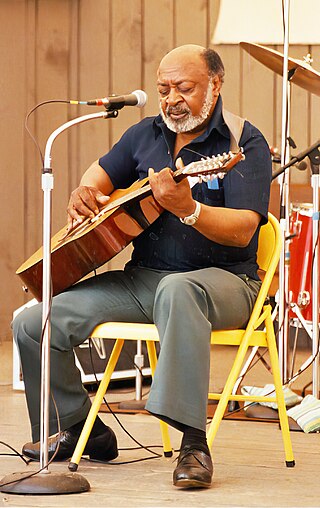
The Shure SM58 is a professional cardioid dynamic microphone, commonly used in live vocal applications. Produced since 1966 by Shure Incorporated, it has built a strong reputation among musicians for its durability and sound, and is still considered the industry standard for live vocal performance microphones to this day. The SM58 is the most popular live vocal microphone in the world. It is a development of the SM57 microphone, which is another industry standard for both live and recorded music. In both cases, SM stands for studio microphone.
The Shure SM57 is a low-impedance cardioid dynamic microphone made by Shure Incorporated and commonly used in live sound reinforcement and studio recording. It is one of the best-selling microphones in the world. It is used extensively in amplified music and has been used for speeches by every U.S. president since its introduction in 1965. In 2004, honoring its four decades of "solid, dependable performance", it was inducted into the first-ever TEC Awards TECnology Hall of Fame.

Georg Neumann GmbH is a manufacturer of professional recording microphones. It was founded in by Georg Neumann in 1928 and is based in Berlin, Germany. Their best-known products are condenser microphones for broadcast, live and music production purposes. For several decades Neumann was also a leading manufacturer of cutting lathes for phonograph disks, and even ventured into the field of mixing desks. Currently it is also a manufacturer of preamplifiers, studio monitors and headphones. Since 2020, Ralf Oehl has been CEO of Georg Neumann GmbH.

The RCA Type 77-DX microphone is a poly-directional ribbon microphone, or pressure-gradient microphone, introduced by the RCA Corporation in 1954. It was preceded by the Type 77-D introduced in 1948. Its popularity and classic design has resulted in the 77-DX becoming an iconic microphone, used by broadcasters and media personalities such as Edward R. Murrow, David Letterman and Larry King.
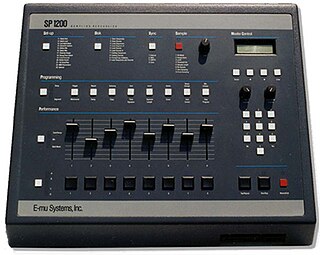
The E-mu SP-1200 is a sampler created by Dave Rossum that was released in August 1987 by E-mu Systems.

There are a number of well-developed microphone techniques used for recording musical, film, or voice sources or picking up sounds as part of sound reinforcement systems. The choice of technique depends on a number of factors, including:

AKG Acoustics is an acoustics engineering and manufacturing company. It was founded in 1947 by Rudolf Görike and Ernest Plass in Vienna, Austria. It is a part of Harman International Industries, a subsidiary of Samsung Electronics since 2017.

Equalization, or simply EQ, in sound recording and reproduction is the process of adjusting the volume of different frequency bands within an audio signal. The circuit or equipment used to achieve this is called an equalizer.

The Shure MV7 is a cardioid dynamic microphone used for podcasting and home studio applications. The MV7 was developed in 2020 by Shure as a digital audio reworking of the classic SM7B professional broadcasting microphone. The MV7 was rated the best podcasting microphone by Rolling Stone in their 2021 Audio Awards.
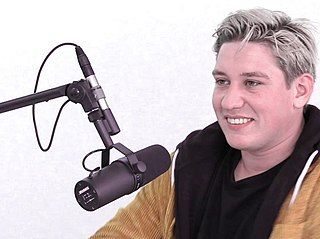
The Shure SM7 is a professional cardioid dynamic microphone, commonly used in broadcasting applications since 1973. Designed by Shure, it has been described as an "iconic" industry standard microphone for its focused, directional sound and its widespread adoption in radio, television and recording studios. In 2007–2008, the SM7B model became popular for professional podcasting.

The Sennheiser MD 421 is a German cardioid dynamic microphone, widely used for speech in broadcasting and for music in live concerts and the recording studio. Introduced in 1960, the internal large-diaphragm transducer element of the MD 421 is still produced unchanged by Sennheiser. The MD 421 is considered a classic, an industry standard. More than 500,000 units have been sold.
